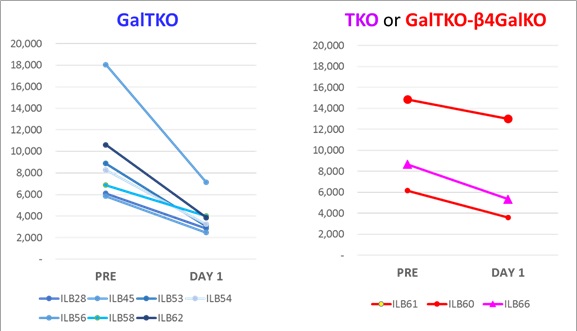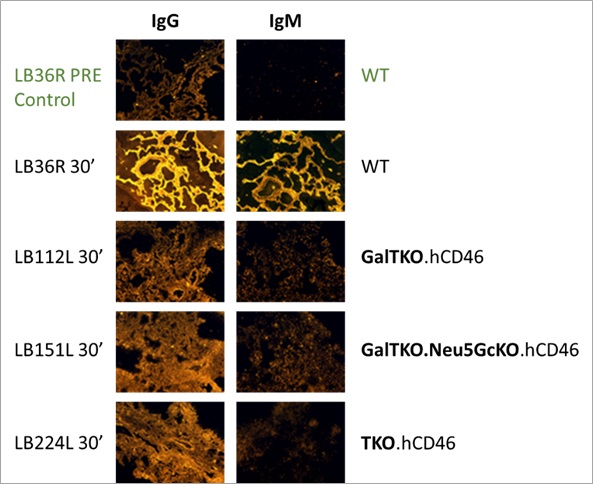Beta4GalKO reduces anti-non Gal antibody binding in pig-to-baboon and pig-to-human lung transplantation models
Lars Burdorf1, Zahra Abady1, Benjamin Cerel1, Kaitlyn Petitpas1, Christopher Laird2, Margaret R. Connolly1, Shannon Pratts1, Xiangfei Cheng2, Carol J. Phelps3, Will Eyestone3, David L. Ayares3, Richard N. Pierson III1, Agnes M. Azimzadeh1.
1Center for Transplantation Sciences, Massachusetts General Hospital, Boston, MA, United States; 2Surgery, University of Maryland, Baltimore, MD, United States; 3Revivicor, Inc, Blacksburg, VA, United States
Purpose: Knock-out (KO) of porcine carbohydrates (CHO), including Gala1,3Gal, inhibits antibody-mediated xenograft rejection. The β4Gal epitope was discovered using serum from xenograft-sensitized baboons, but whether humans and baboons have detectable titers of preformed antibody (as they do for Neu5Gc), and whether anti-β4Gal antibody modulates lung xenograft injury, remains controversial.
Methods: In serum from 14 baboons, pre-lung transplant and post-op day1 anti-pig Ab binding against GalTKO versus GalTKO.β4GalKO (double KO (DKO)) porcine aortic endothelial cells (PAECs) was measured in animals that had received a lung from a GalTKO pig and compared to those in which the donor animal had β4GalKO (or knock down), with (TKO) or without (DKO) additional Neu5GcKO. To evaluate Ab binding to pig tissue, lung biopsies from wildtype, GalTKO, DKO and TKO pigs after 30min of ex vivo xeno-perfusion with human blood were stained for IgG and IgM binding. In one case Ab binding to GalTKO and DKO cells was also measured at 1 and 31d in a long-surviving xenolung recipient.
Results: In naïve baboons, IgM Ab binding was consistently lower on GalTKO.β4GalKO relative to GalTKO PAECs. Decline in anti-non-Gal Ab levels on post-op d1 in vivo was consistently less using GalTKO.β4GalKO lungs (31%±16%, n=3) when compared to single KO lungs (58%±16%, n=7)(Fig.1). In a long-surviving LTX recipient animal, sensitized anti-non Gal antibody binding was almost completely abrogated when using TKO cells. By IHC, lungs with multiple CHO KOs appear to show decreased IgM tissue deposition relative to GalTKO lungs after perfusion with human blood (Fig.2).
Conclusion: Binding of preformed antibody (IgM>IgG) in humans and baboons is reduced by β4GalKO, and β4Gal is a dominant antigen after lung xenotransplantation. Since the β4Gal epitope presumably contributes to pig lung xenograft injury, including the β4GalKO modification in donor pigs will likely help to better control Ab-mediated xenorejection pathways and advance xenotransplantation of the lung and other organs towards the clinic.


NIH P01 HL107152, U19 AI090959. Unrestricted educational gifts from United Therapeutics/ Lung Biotechnology LLC.
There are no comments yet...